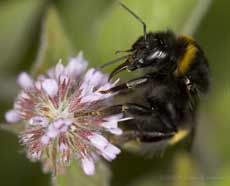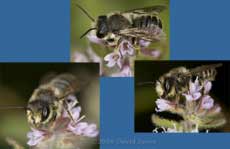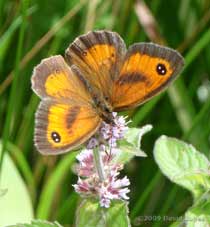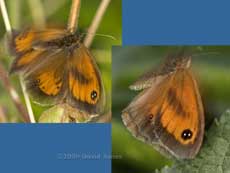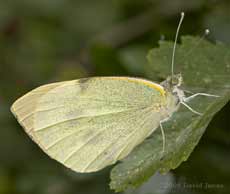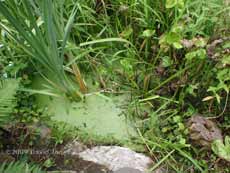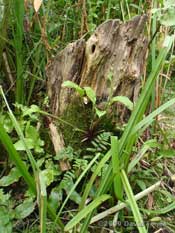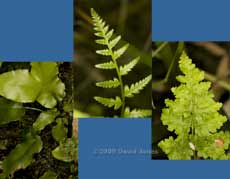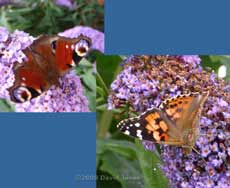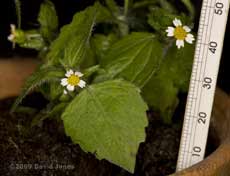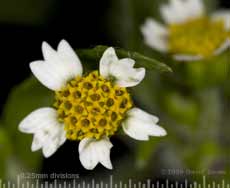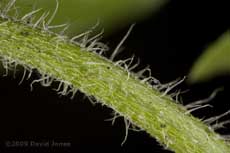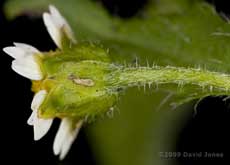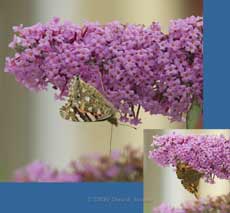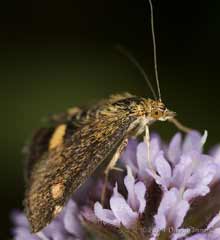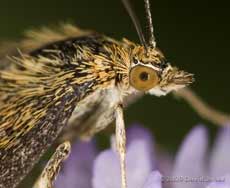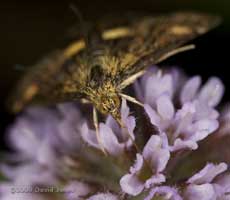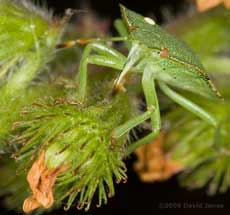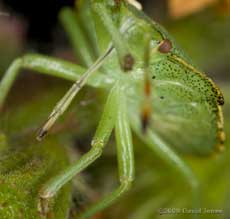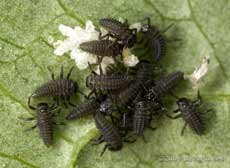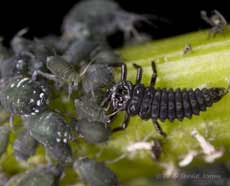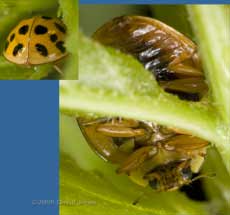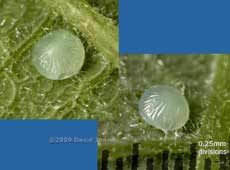Go to the last entry on this page .....Go to previous entry22 July - With the weather continuing to be almost autumnal, today has been mainly cloudy with a constant breeze from the south-west, and the temperature only just reached 20C. The garden still seems to be sadly lacking in insects, although when the sun did shine the couple of mint flowers open so far did attract a few customers.
The first visitor that I saw, a Common Garden Bumblebee, didn't wait for the sunshine. The bumblebees are able to generate energy even when it is cloudy.
When the sun did shine, a small number of solitary bees emerged to visit the mint and other flowers in the garden. I have yet to try and identify this species.
The most noticeable visitor to the mint was this Gatekeeper butterfly, although it seemed to spend most of its time in spots that provided shelter from the breeze, especially when clouds covered the sun.
The picture above was taken with my waterproof Olympus. The camera is silent and I didn't use flash - the butterfly ignored it. When I tried to take more pictures with the Canon and a ring flash, it was a different matter. These two pictures show what happened each time I pressed the shutter. The shutter speed was 1/200sec and the flash went off as soon as the shutter curtain opened. However, the milliseconds it took for this to happen was sufficient for the butterfly to react and take off! Its reaction times were also demonstrated when it was pursued across the pond by a wasp!
The only other butterfly seen in the garden today was this Large White. Unlike the Gatekeeper, this individual didn't react at all to the same camera/flash combination being used a very short distance away.
As this picture shows, plants in the pond have flourished more than ever this Spring, and I will need to clear quite a lot by the end of the summer. In the bottom-right corner of the picture you can see a small log.
I put this into the pond several years ago and have largely ignored it ever since. Gradually, moss has spread around the damp areas, but more interestingly some ferns have appeared on it.
I knew that there was one type of fern present, but it wasn't until today, when I cleared a bit to one side of the log that I discovered that there are in fact three species growing on it.
The one on the right seems to be a Bladder Fern - I don't recall bringing any of these into the garden, but I'll have to check again. The middle one I have no idea about its ID.
Over the years I have planted ferns in the border on the southern side of the garden because they thrive in the shade that causes problems for many plants. Some of those ferns have grown quite large now, but this is the first time I've seen evidence that any may have produced offspring here.
28 July - A day that has been the brightest for a few days, with no threat of rain. The main part of today's entry is based on a couple of hours away from mybitoftheplanet. First, this afternoon we spent a couple of hours visiting our beautiful little grand-daughter (and her dad) who lives less than a mile from us. IN their garden they have two Buddleia plants, one with the same colour pink flowers as the one we have, and one with rather more purple blooms. When the sun shone we were treated to the welcome sight of butterflies visiting both bushes. There were large and Small Whites, and a Gatekeeper, but the stars were several Peacock butterflies, and four Painted Ladies. While the Peacocks looked a bit worn, the Painted Ladies all looked very fresh indeed. These are no doubt the offspring of individuals that arrived in the UK during the invasion in May, and which we encountered in a big way on our Cornish trip (still waiting to be added - sorry!).
Erin (our grand-daughter, aged 1 and a bit) loves getting close to insects and I was able to get her within (her) arm's length of a Peacock butterfly, but the Painted Ladies were a bit too wary. It was interesting to see that there were more butterfly visits made to the darker Buddleia during our stay. Shortly afterwards we found an adult bush cricket and she allowed it to crawl on her hand for a few moments! On our way home I needed to call in our local post office. These days, the local council doesn't use weed killer very often on footpaths, so it's always worth checking what plants have managed to establish themselves.
Today I did what I intended to do, but didn't get around to in 2006, I brought home a small plant and took some close-up photographs.
A member of the daisy family, the flower head is made up of yellow florets, and has five white ray florets, each of which has a three-pronged outer edge. That would appear to be in conflict with the latin species name (quadriradiata) which means 'four-rayed'.
Both stems and leaves are covered with hairs.
However, many of the hairs on the flower stalks have small globules at their ends.
The plant is now in a pot and if I can manage to look after it for long enough(!) I hope to get some photographs of the seed heads as they are produced. I notice too, that one of its leaves has become 'home' to a leaf mining insect larva - perhaps I'll take a closer look tomorrow. I'm not sure if I've mentioned it before, but we have suspected for several weeks that a fox has taken up residence in a hidden spot behind the shed at the bottom of the garden. I have disturbed it without seeing it a couple of times (wasn't sure that it wasn't a cat), and on one occasion it ran past my son. On the weekend my neighbour saw it twice, the first time on the roof of his car port (sun bathing?) and then it looked over the fence when he was at the bottom of his garden. Well, this morning I found where it is actually hiding, at least I caught a glimpse of its snout before it withdrew into cover. It looks like a good reason to set up a new cctv camera position to monitor its comings and goings, although it isn't in the most camera-friendly spot, in a well shaded spot under some wide shelving.
29 July - A really blustery day, with very brief bright spells between fast moving cloud cover being pushed by a strong south westerly breeze. At least, apart form a couple of short damp periods it stayed dry during the morning and afternoon.
Despite the conditions, the bright spells have encouraged a first Painted Lady butterfly to visit our Buddleia, although it has not been possible to get decent pictures of is so far. Like the ones we saw yesterday, this looked fresh, with bright, bold colours.
Down by the big pond there are a few more inflorescences opening up on the mint plants, but with few insects taking advantage of them today. Having said that, the Gatekeeper came during a morning bright spell, although it didn't stay long. Once again it was chased by a wasp which had been hunting for prey amongst the mint plants.
Also making an appearance was a Pyrausta aurata, a species of micro-moth - the mint is the food plant for its caterpillars. While I managed to photograph a female egg-laying last year I have yet to find any of their caterpillars.
These are very pretty insects, although once you start looking closely at them, their relatively large scales give them a decidedly scruffy appearance. Look carefully and you can see one of its small, simple eyes (or ocelli) just above the much larger compound eye. These probably cannot 'see' images but can measure light intensity - useful on a day like today!
While the sun shone the moth fed, poking its long proboscis down into the mint flowers, but stopped when clouds moved in again.
When the bug isn't feeding, the long, piercing mouth part, the rostrum, is held straight back under the body. However, in the large version of this picture you can see that as the bug is feeding, the rostrum is not just folded down, but is also bent to expose the much more slender proboscis through which plant sap is actually being drawn up.
Feeding over, the dark proboscis is once more enclosed in its rostrum sheath, with a bit of help from a leg.
30 July - A largely bright and sunny day, although the middle of the day was marred by showers, and there has been a constant quite strong breeze which helped keep the temperature down below 20C all day. I saw a couple of P. aurata today. I must watch out for a chance to photograph variations in the individuals that I see, as I understand from Tim Norris that the males have more yellow on them. I continue to watch out for ladybirds to start reappearing in the garden. This morning I saw a sign that there are more on the way, although I fear they are probably going to be Harlequins.
I spotted this group of larvae on an Elder leaf. While they are all black I suspect that they are Harlequin Ladybird larvae.
On a nearby stem I found this slightly older example which had found itself a source of food, in the form of black Aphids, that should last it a while. This one is just starting to develop to orange markings on its back.
It was probably coincidental that tucked in between the leaves at the end of the stem was an adult Harlequin that was obviously in a resting state. You can see how the white of the pronotum (the upper thorax) is continued right around the underside of the body, although it appears to be yellow in this case.
Next to the Elder, the Willow also demanded the attention of my camera when I found that on numerous leaves there were single eggs, probably laid by a butterfly or moth. I also found a small, green caterpillar, about 1cm long, although I couldn't find it again once I had the camera with me.
Click on images to see larger versions |
|
